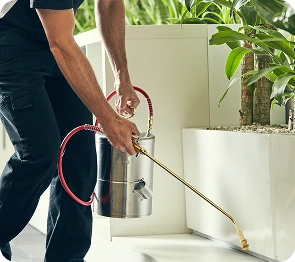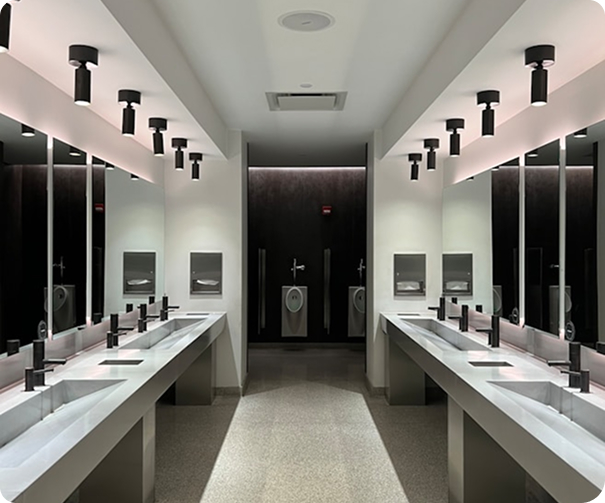Beetles Pest Control and Treatment
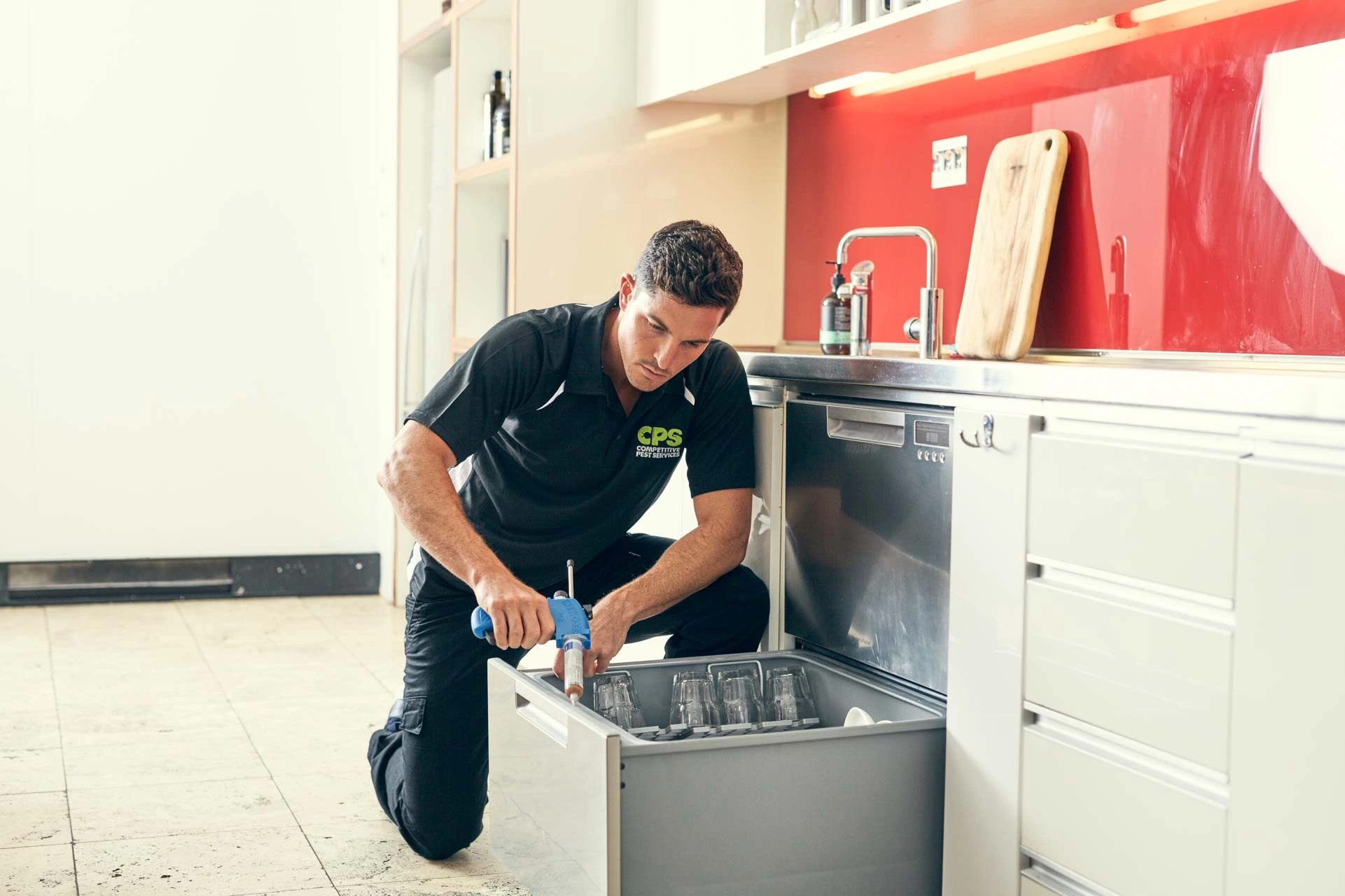

Beetles Pest Control
Beetles are one of the most diverse groups of insects in the world, with more than 20,000 species found in Australia. They belong to the order Coleoptera and are characterised by their hardened forewings, called elytra, which protect their delicate flight wings underneath.
Many beetles are harmless or beneficial — recycling organic matter, controlling other pests, or pollinating plants — but some species are destructive household and structural pests. Carpet beetles, pantry beetles, and wood-boring beetles, for instance, can damage fabrics, stored foods, and timber, making them a nuisance in both homes and businesses.
What Do Beetles Look Like?
Beetles vary greatly in appearance depending on the species, but most have a hard, shell-like body with wing covers that meet in a straight line down their back. They can range from just a few millimetres to several centimetres long.
Adult carpet beetles, one of the most common indoor pest beetles, are small and oval-shaped, measuring around 2–3 mm. They are typically dark in colour, often black, with legs that are not easily seen. The larvae — often called “woolly bears” — are 4–7 mm long, slow-moving, and covered in bristly hairs. These larvae are the destructive stage, feeding on fabrics and organic materials for months before pupating.
Other pest beetles, such as pantry beetles, are reddish-brown and attack stored foods, while wood-boring beetles are usually small, cylindrical, and dark brown, resembling grains of rice.
Where Do Beetles Live?
Beetles are highly adaptable and can be found in nearly every environment across Australia. Outdoors, they inhabit soil, under bark, plants, and decaying organic matter. Indoors, pest beetles establish themselves where food or suitable materials are available.
Carpet beetles are widespread in homes and buildings, feeding on wool carpets, rugs, clothing, furs, feathers, hides, and silk. They may also attack plant-based fabrics like cotton and linen if these are stained with food or organic matter. Pantry beetles infest dried food goods such as cereals, nuts, and grains, while wood-boring beetles live inside timber structures, emerging only as adults after years of hidden damage.
Common Types of Beetles in Australia
Australia is home to thousands of beetle species, many of which are harmless or even beneficial in the environment. However, several beetles are notorious household and structural pests. They infest stored food, damage fabrics and furnishings, or weaken timber from within. Below are the most common pest beetles you are likely to encounter in Australia.
Carpet Beetles (Anthrenus spp. And Attagenus spp.)
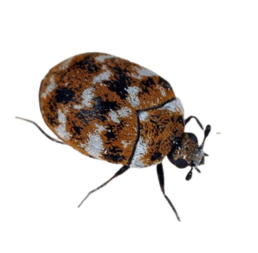
How they look
Adult carpet beetles are small, oval-shaped, and dark in colour, typically 2–3 mm long. They may appear black or mottled with white, yellow, or brown patches depending on the species. The larvae, known as “woolly bears,” are 4–7 mm long, slow-moving, and covered in bristly hairs.
Where they live
Carpet beetles are found throughout Australian homes and buildings, hiding in carpets, rugs, clothing, upholstered furniture, air ducts, and behind skirting boards. Adults are often seen near windows as they are attracted to light, while larvae prefer dark, undisturbed areas.
Why they are a problem
Larvae cause extensive damage by feeding on natural fibres such as wool, silk, fur, feathers, and leather. They will also attack cotton and linen if stained with food or perspiration. In severe infestations, they can ruin valuable clothing, carpets, museum specimens, and taxidermy collections.
Pantry Beetles (Stored Product Pests)

How they look
Several beetle species infest stored foods, including the Cigarette Beetle (Lasioderma serricorne) and Drugstore Beetle (Stegobium paniceum). These are small, reddish-brown beetles around 2–4 mm long, with cylindrical bodies. Their larvae are cream-coloured grubs that tunnel into dry foods.
Where they live
Pantry beetles infest dried food products such as flour, cereals, rice, pasta, nuts, dried fruit, spices, and even tobacco. Infestations often start in food purchased from shops or warehouses and spread once brought into the home.
Why they are a problem
They contaminate food with larvae, frass (droppings), and webbing, making it unfit for consumption. Infestations can spread rapidly in pantries, leading to widespread food spoilage.
Wood-Boring Beetles (Borers)
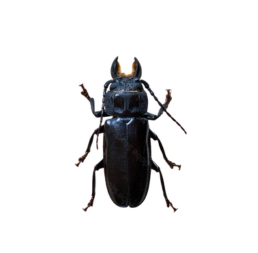
How they look
Wood-boring beetles include several species such as the Common Furniture Beetle (Anobium punctatum), Powderpost Beetle (Lyctus spp.), and Longhorn Beetles (Cerambycidae family). Adults range in size from 3 mm to over 20 mm, often brown to black, with larvae that are creamy-white grubs tunnelling deep within wood.
Where they live
They infest structural timber, flooring, furniture, and outdoor wooden structures. While some prefer softwoods, others target hardwoods, especially when untreated or damp.
Why they are a problem
Their larvae can live for years inside timber, weakening it from within before adults emerge through exit holes. Severe infestations may compromise flooring, beams, and even the structural safety of homes.
Hide Beetles (Dermestes maculatus)
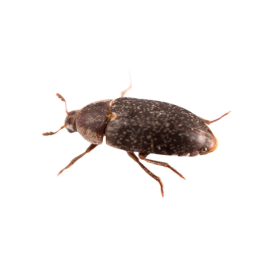
How they look
Hide beetles are oval, dark brown to black beetles, about 6–10 mm long. Their larvae are hairy and resemble small carpet beetle larvae but are larger.
Where they live
Often found in dry animal matter, hide beetles infest skins, hides, meat scraps, dried fish, pet food, and taxidermy specimens.
Why they are a problem
Hide beetles are particularly destructive in museums and taxidermy collections, where they consume preserved animal specimens. They can also infest poorly stored pet food, causing contamination and loss.
Warehouse Beetle (Trogoderma variabile)
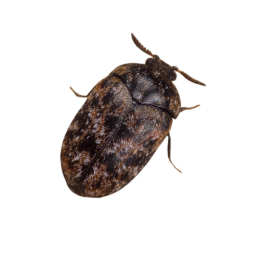
How they look
A close relative of the carpet beetle, about 2–3 mm long, oval-shaped, with a mottled brown appearance.
Where they live
Infests stored foods such as cereals, dried legumes, nuts, seeds, and pet food.
Why they are a problem
Hide beetles are particularly destructive in museums and taxidermy collections, where they consume preserved animal specimens. They can also infest poorly stored pet food, causing contamination and loss.
Christmas Beetle (Anophlognathus species)
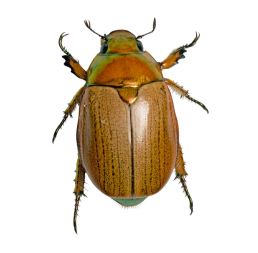
How they look
Christmas beetles are large, robust beetles ranging from 20–30 mm long. They are best known for their striking metallic colours, often green, gold, or bronze, which make them highly visible when they swarm in summer.
Where they live
They are most active during the warmer months, especially around Christmas — hence their name. Adult beetles are attracted to lights at night and are commonly seen around homes and gardens in large numbers. Their larvae, known as “curl grubs,” live underground and feed on grass roots.
Why they are a problem
While adult Christmas beetles are not harmful to people, they can cause significant defoliation of eucalyptus trees when present in large swarms. Their larvae can also damage lawns and turf by feeding on root systems, leading to browning or dieback. Indoors, they are mainly a nuisance pest, entering houses accidentally when drawn to artificial lighting.
How to Identify Beetle Infestations
Beetle infestations in Australia vary depending on the species, but they all leave behind distinctive signs of their presence. Whether they are attacking food, fabrics, or timber, beetles are usually detected more by the damage they cause than by seeing the insects themselves. Early recognition is crucial because infestations often grow quietly for months before becoming obvious.
Damage to Fabrics and Furnishings
Carpet beetles and their larvae are notorious for destroying natural fibres. Look for irregular holes in wool carpets, silk clothing, upholstered furniture, or fur. Shedding skins and small, bristly larvae may be found in wardrobes, under rugs, or behind skirting boards. In severe cases, bald patches appear on carpets and clothing, particularly in areas undisturbed by regular cleaning.
Contaminated Food Products
Pantry beetles such as the drugstore beetle and cigarette beetle infest cereals, flour, rice, pasta, spices, dried fruit, and even pet food. Infested products often develop an unusual odour, clumping, or fine webbing. Larvae and adults may be seen crawling inside packaging, while tiny holes in cardboard or plastic containers signal entry points. Any discovery of live beetles or wriggling larvae in stored goods is a clear sign of infestation.
Exit Holes and Frass in Timber
Wood-boring beetles (borers) cause structural damage that may not be noticed until it is advanced. Tell-tale signs include small, round or oval exit holes on the surface of furniture, flooring, or beams. Beneath these holes, you may find frass — a fine, powdery dust created as larvae tunnel through the wood. Weakened or crumbling timber, sagging floors, or cracked beams are signs of heavy infestation, often requiring urgent professional treatment.
Shed Skins and Larval Hairs
Warehouse beetles and hide beetles leave behind cast skins and tiny larval hairs. These can contaminate food products and may trigger allergic reactions in sensitive individuals. If you find fine hairs, shed skins, or unexplained irritation when handling stored goods, it may indicate beetle activity.
Large Numbers of Adult Beetles
While larvae do most of the damage, adult beetles are often noticed first. Carpet beetle adults may be seen crawling on window sills, drawn to sunlight, while pantry beetles are spotted in kitchens and pantries. Large, dark beetles emerging from timber or found in food storage areas suggest a mature infestation that has been active for months or even years.
Signs of Heavy Infestation
In advanced cases, beetle activity becomes widespread and far more destructive. Clothing, rugs, and furniture may show extensive patchy damage, often with live larvae clearly visible. In the kitchen, multiple food packets can be contaminated, while adult beetles are seen flying or crawling around pantries and cupboards.
Timber pests leave behind numerous exit holes, piles of fine frass, and weakened structures such as sagging floors or cracking beams. Adults and larvae may also be spotted in several areas of the home, suggesting that the infestation has spread well beyond its original source.
At this stage, professional intervention is strongly recommended, as beetle infestations can quickly escalate. Many species have long lifecycles and can survive unnoticed for months, making them particularly difficult to eliminate without expert help.
How to Prevent Beetle Infestations
Beetles are one of the most diverse groups of pests, capable of damaging food, fabrics, and even timber. While adult beetles may be visible, most of the destruction is caused by their larvae feeding on stored goods, clothing, or wood. Preventing beetle infestations is always easier than dealing with them once established. By protecting your food, fabrics, and furniture and maintaining a clean environment, you can significantly reduce the risk of infestation.
Protect Food Storage
Many beetles, such as pantry beetles, thrive in stored grains, cereals, and dry goods. Always keep food in sealed containers made of glass, metal, or sturdy plastic, rather than cardboard or thin bags that beetles can chew through. Check packaging for small holes before purchasing, and avoid stockpiling food for long periods. Rotate items regularly and discard expired or suspicious products promptly.
Safeguard Fabrics and Clothing
Carpet beetles and other fabric pests target wool, silk, and natural fibres, especially when soiled. Store off-season clothing in sealed containers or garment bags, ideally with mothballs or cedar blocks as deterrents. Wash or dry-clean clothing before storing, and vacuum rugs, carpets, and upholstery regularly to remove lint, pet hair, and food crumbs that attract beetles.
Protect Timber and Furniture
Wood-boring beetles lay their eggs in untreated timber, where larvae can tunnel unnoticed for years. Choose kiln-dried or pre-treated timber for renovations and repairs, and consider applying protective sealants to exposed wooden surfaces. Avoid bringing untreated firewood or second-hand wooden furniture indoors without careful inspection.
Maintain Cleanliness
A clean home is one of the best defences against beetles. Vacuum and dust regularly, paying close attention to dark corners, baseboards, under furniture, and inside wardrobes or cupboards. Dispose of vacuum bags promptly, as beetle eggs and larvae can survive inside. Clean pantry shelves with warm, soapy water to remove food residue that may attract pests.
Reduce Clutter and Hiding Spots
Beetles thrive in undisturbed, cluttered spaces. Avoid letting stacks of old fabric, papers, or boxes accumulate in storage areas. Organise cupboards, wardrobes, and sheds to make inspection easier, and keep storage areas dry and well-ventilated to prevent conditions that beetles prefer.
Monitor for Early Signs
Regularly check your home for early warning signs such as small holes in food packaging, damaged fabrics, or fine powdery frass near timber. Early detection allows for faster intervention before beetles spread to multiple areas of the property.
How to Get Rid of Beetle Infestations
Beetle infestations can be stubborn because they often go unnoticed until damage is already significant. Whether they are feeding on pantry goods, clothing, or timber, beetles multiply quickly and their larvae can survive hidden away for weeks, months, or even years. Once you’ve spotted the signs of an infestation, immediate action is crucial to stop further spread.
At-Home Actions to Get Rid Of Beetles
Remove Infested Items
The first step in tackling a beetle infestation is to eliminate the source. For pantry beetles, discard any contaminated food — even sealed bags and boxes, as eggs and larvae can be inside. For fabric pests, wash or dry-clean infested clothing, rugs, or upholstery at high temperatures to kill all life stages. Severely damaged items may need to be disposed of.
Thorough Cleaning
Vacuum floors, rugs, and furniture carefully, especially in cracks, crevices, and hidden corners where beetle eggs and larvae may hide. For pantry beetles, wipe cupboards with warm, soapy water, paying attention to seams, hinges, and shelf joints where eggs can be laid. Dispose of vacuum contents immediately to prevent re-infestation.
Freezing and Heat Treatments
Small fabric items or dry food products can sometimes be salvaged by placing them in the freezer for at least 72 hours, which kills beetle eggs and larvae. Alternatively, heat treatments such as washing fabrics in hot water or baking infested dry goods in the oven at low heat can also eliminate pests.
Use of Insecticides (with Caution)
Insecticidal sprays and dusts may be applied to cracks, baseboards, or affected furniture, but these should be used carefully and only on non-food surfaces. Always follow safety instructions and avoid applying insecticides directly to food storage or clothing.
Professional Beetle Treatments
Residual Surface Sprays
Licensed pest controllers can apply long-lasting insecticides to affected areas, targeting beetles that emerge from hiding or attempt to re-infest. These treatments provide broader coverage than DIY sprays.
Fumigation
For severe infestations, particularly of timber or stored products, fumigation may be necessary. This process penetrates deep into wood, fabrics, or storage areas, killing all life stages of beetles, including hidden larvae.
Heat or Cold Treatments
Professionals may use specialised heat chambers or freezing methods for sensitive items like museum specimens, antique furniture, or clothing collections, which cannot be treated with chemicals.
Targeted Species Identification
Because treatment varies depending on whether beetles are pantry pests, fabric pests, or wood borers, pest controllers begin with precise species identification. This ensures the right method is used for long-term effectiveness.
Call a Pest Control Professional
Beetle infestations can escalate quickly, especially in food storage, timber structures, or valuable fabrics. Left untreated, they may cause ongoing damage, contamination, and financial loss. A licensed pest control professional can:
- Identify the specific beetle species.
- Assess the extent of the infestation.
- Apply safe, effective treatments tailored to your property.
- Recommend long-term prevention strategies.
Need help now? Book a professional beetle inspection on 1300 766 614. Our experts will locate the source, eliminate the infestation, and help safeguard your home against future beetle problems.
Frequently Asked Questions (FAQ)
What do beetles eat?
Beetles have highly varied diets depending on the species. Carpet beetle larvae feed on natural fibres such as wool, silk, feathers, and animal products, while pantry beetles infest dry goods like flour, cereals, grains, and nuts. Wood-boring beetles consume timber during their larval stage, leaving behind exit holes and frass. Outdoors, beetles may feed on plants, roots, or even other insects.
Are Christmas beetles dangerous?
No, Christmas beetles are not dangerous to humans or pets. They do not bite or sting. However, they can cause damage to the environment, especially eucalyptus trees, which they strip of leaves when swarming in large numbers. Their larvae (curl grubs) can also damage lawns by feeding on grass roots.
How long do Christmas beetles live?
The adult Christmas beetle lives for only a few weeks to a couple of months, typically appearing in late spring and summer. Most of their lifecycle is spent underground as larvae, where they may remain for one to two years before emerging as adults.
Do beetles bite?
Most beetles found in and around homes do not bite humans. While some larger beetles have strong jaws and may pinch if handled, bites are rare and generally harmless. Beetles are considered more of a nuisance or destructive pest (to food, fabrics, or timber) than a direct danger to people.
Can carpet beetles fly?
Yes, adult carpet beetles can fly and are often seen near windows or lights as they try to move indoors. However, it is the larvae — not the flying adults — that cause damage to fabrics, carpets, and stored materials by feeding on natural fibres.
Pest control for the home and business
We offer expert pest eradication and prevention services for every environment – from homes and commercial kitchens to healthcare and offices. Explore the solutions we provide to keep your spaces safe, clean, and protected long-term.
Common pests we deal with
We deliver tailored, long-lasting pest control with a focus on safety, service and results.
From ants and cockroaches to bed bugs and pantry pests, we treat the full range of infestations found in Australian homes and businesses. Our trained technicians know how to identify the issue quickly and apply the right solution to remove pests – and keep them from coming back.
Ants are attracted to food sources and can contaminate food areas, often requiring professional help to locate and remove nests.
Bed bugs infestations are notoriously difficult to beat and hide in bedding and furniture, leaving bites and stains as signs of infestation.
Cockroaches thrive in warm, moist environments, breed quickly, and can leave behind odours and stains—early treatment is key.
Fleas feed on blood, mostly living off pets, and can survive dormant in the environment for months. Professional treatment is often needed.
Silverfish are fast, wingless insects that prefer warm, dark areas and can live for years, feeding on starchy or synthetic materials.
The formidable appearance and size of spiders makes them the most feared of all the creepy crawlies. However most spiders are harmless and avoid people.
Ants invade homes in search of food and water, often forming large colonies. They’re best controlled by removing food sources, sealing entry points, and applying professional treatments to eliminate nests.
Pantry moths infest dry food and can contaminate large amounts of it with webbing and droppings, regular checks and baits help prevent them.
Carpet beetles damage rugs and feed on hair, skin, and feathers, often going unnoticed until larvae husks or damage appears in hidden spaces.
Rodent control that removes the risk — fast and for good
Rats and mice pose serious health, safety and hygiene risks for homes and businesses. Our trained technicians quickly identify entry points, eliminate infestations, and implement proven prevention measures to keep rodents out for good.
Bird problems controlled with expert, long-term solutions
Birds can damage buildings, spread disease, and disrupt operations. We provide specialist bird control using proven methods and premium materials—designed to stop nesting, roosting and mess, and keep birds from coming back.
Termite protection that stops damage before it starts
Termites can silently destroy timber structures, causing costly and sometimes irreversible damage. Our licensed technicians use advanced detection tools and proven treatment systems to eliminate colonies and protect your property long-term.
Bed bug infestations found fast — and stopped for good
Bed bugs can spread quickly, cause discomfort, and damage your reputation if left untreated. Our expert team knows how to detect the early signs, eliminate infestations at the source, and prevent them from coming back with proven, long-term solutions.
National hygiene service. Local teams you can trust.
We deliver consistent, high-quality hygiene services to businesses across Australia. Unlike global franchises or contractors, our full-time staff operate nationwide—so you get reliable service, clear accountability, and a standard of care you can trust, no matter where you are.
Safe for families and pets
We work with the latest in safe pest control technologies and treatments, keeping your staff and customers safe. Our professionally trained technicians use targeted solutions at the source of the problem to keep bugs out and keep your business safe.
Our ISO1401 certification for environmental impact management and HACCP food safety certification means you can trust Competitive Pest Control Services care about the safety and protection of your facility.
Our technicians use only the safest, environmentally friendly treatments available in and around your home, to keep pests at bay giving you peace of mind as the kids continue to play in a safe and healthy environment.
There’s more to effective pest control than chemicals. We target our applications to the source of the problem from enhanced inspections to exclusion methods followed by protection.
All our treatments are environmentally friendly, because we love the Earth as much as you do. Our expertise enables us to keep chemical application to a minimum to keep the pests away, and we’re 100% carbon neutral.

